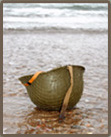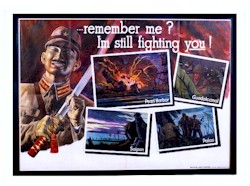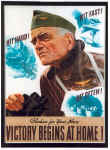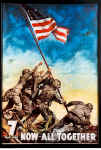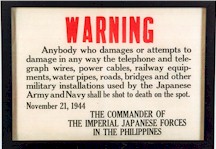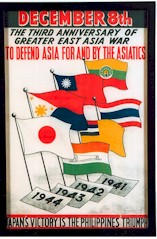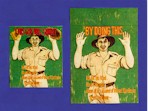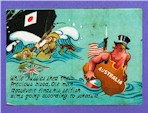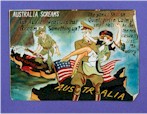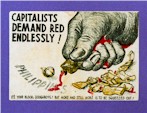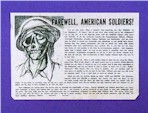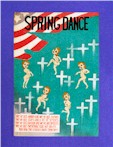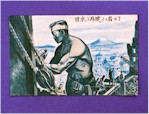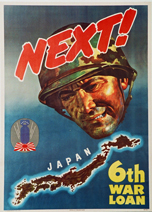 |
The Pacific is much more limited in collecting than the European theater. Marines, and to a much lesser extent army soldiers, landed on islands of value only for their geography, there were no cities to mail souvenirs home, and they re-embarked on transport ships with what little could fit in their packs. The most common artifact is a Japanese flag – easily carried by both Japanese and marines. The air war provided very few artifacts as did the Naval.
Occupied Japan did not provide the artifacts Germany did; for one thing, everything that could burn was burned by incendiary bombs. For another, the occupying American forces, lacking any oriental heritage just weren’t interested in anything other than Samurai swords. |
|
| |
|
| |
 |
Many of Japan's offensive weapons from machine guns to an extremely rare fire bomb carried by a Japanese paper balloon over North America are exhibited. American weapons exhibited in this area including a depth charge, a flame thrower, and a 16 inch shell from a battleship. Also in the foreground is a Hotchkiss 13.2 mm antiaircraft machine gun. |
|
| |
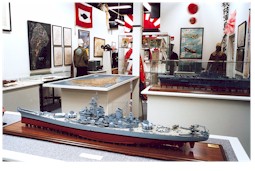 |
Post war models of the battleship U.S.S. Missouri and aircraft carrier Intrepid. |
|
| |
 |
Post war model of a PT boat. |
 |
A variety of uniforms from the Pacific Theater. |
|
| |
 |
Letter from President Franklin D. Roosevelt, June 10, 1934, issuing early anti-Japanese economic sanctions during the attacks on China. |
|
| |
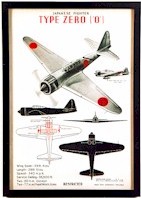 |
 |
Franklin D. Roosevelt |
|
| |
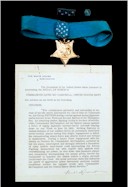 |
In 1944, Commander David McCampbell, a fighter pilot with the United States Navy, was awarded the Medal of Honor for his role in the First and Second Battles of the Philippine Sea. His Medal of Honor and the citation letter from President Roosevelt are shown.
The President of the United States takes pleasure in presenting the MEDAL OF HONOR to COMMANDER DAVID MC CAMPBELL, UNITED STATES NAVY for service as set forth in the following
CITATION:
“For conspicuous gallantry and intrepidity at the risk of his life above and beyond the call of duty as Commander, Air Group FIFTEEN during combat against enemy Japanese aerial forces in the First and Second Battles of the Philippine Sea. An inspiring leader, fighting boldly in the face of terrific odds, Commander McCampbell led his fighter planes against a force of eighty Japanese carrier-based aircraft bearing down on our Fleet of June 19, 1944. Striking fiercely in valiant defense of our surface force, he personally destroyed seven hostile planes during this single engagement in which the outnumbering attack force was utterly routed and virtually annihilated. During a major Fleet engagement with the enemy on October 24, Commander McCampbell, assisted by but one plane, intercepted and daringly attacked a formation of sixty hostile land-based craft approaching our forces. Fighting desperately but with superb skill against such overwhelming air power, he shot down nine Japanese planes and, completely disorganizing the enemy group, forced the remainder to abandon the attack before a single aircraft could reach the Fleet. His great personal valor and indomitable spirit of aggression under extremely perilous combat of conditions reflect the highest credit upon Commander McCampbell and the United States Naval Service.” |
|
| |
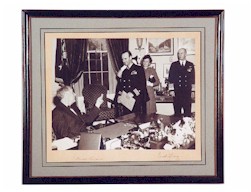 |
David McCampbell is presented with the Medal of Honor by FDR and was given this photograph signed by FDR & National Chief of Staff, Admiral King. |
|
| |
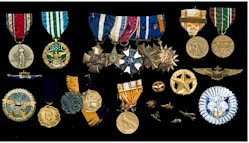 |
Other medals awarded to David McCampbell during World War II included the Navy Cross, the Legion of Merit and the Distinguished Flying Cross. |
|
| |
 |
Propeller from a Japanese plane that crashed on the aircaft carrier Essex during the "Great Marianas Turkey Shoot". |
|
| |
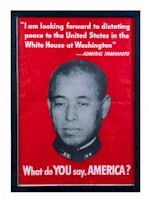 |
Admiral Isoruko Yamamoto was Japan's greatest military leader. He opposed war with the United States because he believed American production would defeat Japan, but once ordered by Emperor Hirihito, he planned the attack on Pearl Harbor. Eliminating Yamamoto was the highest priority of the American forces. The American High Command, through breaking the Japanese code, learned of Yamamoto's flight plans of April 18, 1943, and believed that killing him was of such importance that they would gamble that the Japanese would not realize that the attack on Yamamoto was anything other than random coincidence. |
|
| |
 |
The diary of Thomas Lanphier, the American P-38 pilot credited with shooting down Yamamoto's plane, April 18, 1943. He has drawn a map and diagram of the interception. |
|
| |
GENERAL DOUGLAS MACARTHUR |
 |
Autograph photo of MacArthur, given to his chief of staff and public relations liaison, Gen. LeGrande Diller. |
 |
MacArthur's Four Star license plate, which he hung over his desk in the tunnel on Corregidor.Many had brought a symbol of their rank from manila to the new headquarters of the embattled american army and for Mac Arthur it was his four star plate. |
|
| |
 |
The original, top-secret evacuation order, dated March 11, 1942, ordering MacArthur and his staff to leave Corregidor: "The following...will proceed by the first available transportation from Fort Hills, Philippine Islands, to destination described in letter of instructions." Pencil notes indicate the PT boats they are assigned. |
|
| |
|
| |

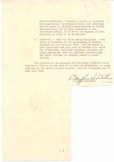 |
MacArthur praises the "Patriots of the Philippines"
"Seldom has a military commander penetrated enemy occupied shores with a greater potential of interior support than that which I today rely upon from the people of the Phillippines.
It is a support whose strength is measured largely in values of the spirit – an unconquerable spirit which despite the ordeal of war still remains unbroken and defiant. Such a spirit, born of a desire and nurtured upon a determination to be free, inevitably overwhelms material force however ruthlessly applied and rises to its heights when the hour for liberation strikes. That hour has struck:….
- Secure your families with such food as is available to you, as rapidly as possible at points away from vital enemy installations which our military forces shall ceaselessly attack with increasing violence until destroyed.
- Support the local commander whom I appoint…if not…the local leader of the resistance movement.
- Avoid any assistance to the enemy, but to the contrary, harass him incessantly…harass him by disrupting his means of communication…destroying his munitions, food, fuel, transport and other vital supplies; and harass him by cutting down or subduing him at every turn, to the end that he may know no rest or relaxation within your community – that no enemy soldier may escape the fate which inexorably confronts all – death or surrender….
- Above all, I call for unity among the people – that unity so essential to the development of maximum strength at this critical time. Let the depth of your patriotism and your love of freedom rise above all differences, factional quarrels, disputes and petty jealousies, that all patriots unflinchingly may march shoulder to shoulder toward a common destiny.
The duration of the campaign and the human suffering which inevitably follows in the wake of war will be determined, in large measure, by the extent of your support." |
|
| |
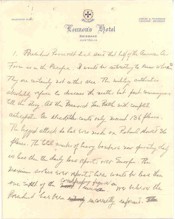 |
Douglas MacArthur, autograph manuscript: "President Roosevelt has said that half of the American Air Force is in the Pacific. It would be interesting to know where. They are certainly not in this area. The military authorities absolutely refuse to discuss the matter but past communiques tell the story. At the Brassock Sea battle with complete anticipation Gen. MacArthur could only mount 136 planes. The biggest attack he has ever made on Rabaul showed 36 planes. The total number of heavy bombers now operating daily is less than the daily loss reported over Europe. The maximum sorties ever reported here would be less than one-sixth of the corresponding figure in Tunisia. We believe the President has been incorrectly informed." |
|
| |
 |
MacArthur inspecting U.S. troops in eastern Australia. |
|
| |
 |
MacArthur praises Australia's war effort, October 29, 1942: "No nation in the world is making a more supreme war effort than Australia. Its resources are relatively meager but it is utilizing them to the utmost. Its effort is universal and embraces equally all classes and all parties. It has unanimously and completely supported me in my military command and the harmony cooperation between Australians and Americans in this area is inspirational. Such internal party differences as exist are largely based upon the desire of one group or the other to accelerate rather than retard the war potential. I am deeply grateful for their magnificent spirit of friendship and understanding without which it would have been difficult to go on." |
|
| |
 |
MacArthur corrected this original copy of a press release to read: "Since my return from the Hollandia operations I have brought to my attention a number of newspaper articles professing in strongest terms a widespread public opinion that it is detrimental to our war effort to have a high officer in high position on active service at the front considered for nomination for the office of President. I have on several occasions announced I was not a candidate for the position. Nevertheless, in view of these circumstances, in order to make my position entirely unequivocal, I request that no action be taken that would link my name in any way with the nomination. I do not covet it nor would I accept it." |
|
| |
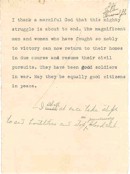 |
MACARTHUR'S STATEMENT ON THE END OF THE WAR WITH JAPAN: "I thank a merciful God that this mighty struggle is about to end. I shall at once take steps to end hostilities and stop unnecessary bloodshed. The magnificent men and women who have fought so nobly to victory can now return to their homes in due course and resume their civil pursuits. They have been good soldiers in war. May they be equally good citizens in peace." |
|
| |
|
|
| |
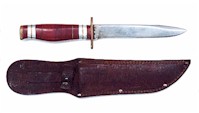 |
Scabbard inscribed by a Marine on Guadalcanal. The handle of the knife is made from pieces of a Japanese airplane. |
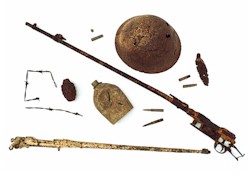 |
Artifacts from Guadalcanal. |
|
| |
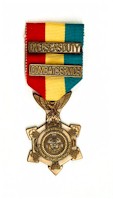 |
Medal for Navajo Nations veterans. Nearly all served as code talkers in the Pacific their unwritten language was never broken by the japanese. |
 |
Flame thrower used in the Pacific Theater. |
|
| |
JAPANESE PROPAGANDA TO ALLIED TROOPS |
|
| |
 |
Submarine indicator for hull openings. The red and green lights, referred to by submariners as "the Christmas Tree", indicated when a ship was in watertight condition for diving. |
 |
|
| |
 |
Depth charge used against Japanese submarines. |
|
| |
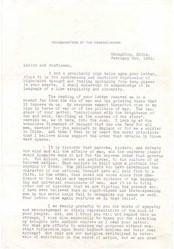 |
 |
Letter from Chiang Kai-Shek, February 3, 1939. |
|
| |
| |
 |
 |
FDR to Chinese dictator Chiang Kai-shek |
|
| |
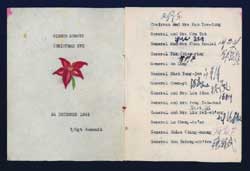 |
The Chinese Leaders and American Advisors Celebrate Christmas Together.On December 24, 1944 a dinner party was given for all the important communist leaders and a group of Americans who were sent to live with the guerillas. They were part of a mission established to consolidate several Chinese factions in their fight against the Japanese. The Americans provided a tree, and decorated it with flash bulbs strung together and used weather balloons with Chinese characters as well.
To commemorate the dinner this program was created and was signed by Mao Tse-Tung, Choe En-lai, and other leaders of the Chinese Red Army. |
|
| |
|
| |
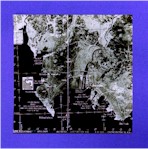 |
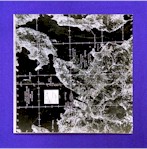 |
U.S. aerial reconnaissance maps of Kyushu, the location of the planned American invasion of Japan. |
|
| |
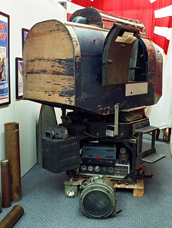 |
Link flight simulator, used to train Navy Fighter Pilots. |
|

